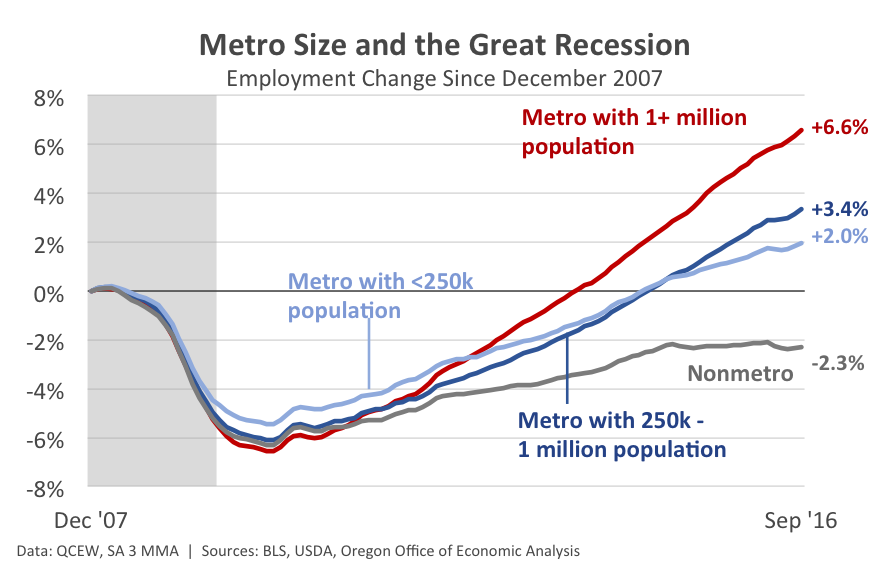What City Observatory did this week
1. The US retail industry is getting marked down in a big way, with hundreds of stores operated by well-established chains including Macy’s, J. C. Penney, and the Gap, as well as others, closing or slated for closing in the next few months. By global standards the U.S. is “over-stored” with far more square feet of retail space per person than similarly rich countries. There’s also a big variation in retail square footage among U.S. metro areas. We review the data for the top 50 metro areas and handicap the cities with the biggest space overhang which may be in line to experience the biggest declines as retailing retrenches.
2. Critical mass and neighborhood revitalization. A few weeks ago, we pushed back on those who criticized Detroit’s nascent recovery as being too unequal, with only a few neighborhoods showing improvement, while others continue to languish or decline. We argued that that city’s rebound, when it comes, will only take off in places where there’s a critical mass of new residents, businesses and investments. A new economic study tries to more precisely estimate the nature and size of these agglomeration economies, and predict which neighborhoods in Detroit have the greatest potential to trigger a positive feedback loop that will drive development forward.
3. How transit influences home values. For a long time, we’ve been highlighting research that shows that walkability is positively correlated with home values. A new study from real estate mavens at Redfin also shows that there’s a positive link between that company’s “Transit Score” measure (which looks at the proximity of transit stops and frequency of bus and train service) and home values. They find that in the typical city, each additional one point on the transit score measure increases a home’s value by about $2,000. Once caveat, in our view: the value gains associated with transit score at least partly reflect the walkability of the most transit served neighborhoods; the underlying source of the gain in both cases is the improved accessibility via all modes of transportation.
4. Big city metros are increasingly driving the US economy. In the recovery from the Great Recession, US job growth has been led chiefly by the nation’s largest metro areas. We show that since the economy last peaked in December 2007, about 87 percent of all net new jobs have been created in metro areas with a population of one million or more. Smaller metro areas have grown only about half as fast as larger metros, and non-metro/rural America is still more than 2 percent below the level of employment it had a decade ago. This is further evidence of how city-centered US economic growth has become.

Must read
1. Building codes that ban small tiny apartments aggravate housing affordability and homelessness. Writing at the Sightline Institute, David Nieman relates latest chapter in the the continuing saga of how building code regulations in otherwise progressive Seattle are making that city’s affordability problems worse. His article–”How Seattle Killed Micro-Housing, Again“–tells how the city has made most forms of congregate housing (where residents may share a bathroom or cooking facilities with neighbors) simply illegal. It’s tried, largely in vain, to legalize 225 square foot efficiency apartments (which must have kitchens, full plumbing and closets), but the city’s specific requirements have steadily (and stealthily) inflated the size and budget of such units. Its a tragic self-inflicted wound.
2. Boring tunnels won’t solve traffic congestion: only road pricing will. UCLA’s Herbie Huff writing the Los Angeles Times schools Elon Musk on the idea that building more roads (whether under or above ground) holds any prospect of ameliorating traffic congestion. This is a nice, well-argued, and non-technical summary of why road pricing can work, and why adding more capacity, by whatever means, will simply be swamped by induced demand unless consumers are asked to pay. Huff pushes back on the usual arguments offered against tolls, noting that they’re both fairer and more efficient than our current system of taxing everyone, and letting queueing ration use.

3. LaCrosse doesn’t want more highway lanes, thank you. Next City’s Rachel Kaufman tell’s of LaCrosse, Wisconsin’s efforts to drag that state’s highway department kicking and screaming into the 21st Century. Like many cities, it has witnessed a big increase in pedestrian and bicycle travel, and the city’s population growth has exceeded that of surrounding suburbs. But state highway planners, still relying on pre-recession forecasts of ever increasing car travel, are calling for more highway capacity through the city.
New ideas
More evidence for the “time-budget” hypothesis. One theory of transportation and commuting behavior holds that humans have a rough optimum daily time budget for travel for regular activities like work. (This is also often called Marchetti’s constant, and is based on the observation that as transportation technologies have changed, from walking, to horse-drawn streetcars, to electric streetcars, then automobiles and mass transportation, that most commute trips average about 30 minutes each direction per day. A new study of travel behavior in Hungary between 1988 and 2010 by Tamas Fleischer and Melinda Tir, finds more evidence of this effect. Even though the total share of travel by private car more than doubled during this period (displacing slower public transit, cycling and walking), total daily travel time stayed almost constant, between 60 and 65 minutes. This suggests that travelers used improved technology (the car) not to save time, but to travel further (to more distant homes or jobs) than they did previously. A relatively fixed time budget means that transportation investments change land use patterns rather than save time.
